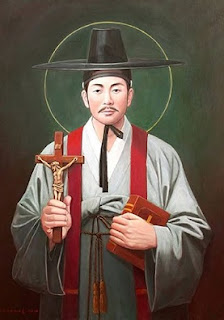St. Andrew Kim Tae-Gon (Sept. 20th)
The Saints remembered this week include:
16 Saints Cornelius, pope and Cyprian, bishop Martyrs
17 St Robert Bellarmine, bishop and doctor
17 St. Hildegard of Bingen, religious and mystic
19 St. Janaurius, bishop and martyr
20 Sts. Andrew Kim Tae-gon and Companions, martyrs
21 St. Matthew, apostle
All are worthy and often fascinating persons to learn about and reflect on.
Since we have a large Korean American population at St. Philip Benizi Parish where I am stationed, I thought to devote my piece this week to St. Andrew Kim Tae-gon and Companions,
The future St. Andrew Kim Tae-gon was born on August 21, 1821 into a Yangban family in the town of Solmoe, near the city of Dangjin, in Korea.
The Yangban formed the traditional gentry / ruling class of Korea, still largely Confusian, at the time.
Since the veneration of ancestors is an integral part of traditional religious practice across East Asia even preceding the Confusian and Taoist philosophical systems which both came to support and even systematize the practice, we know something of St. Andrew Kim Tae-gon’s ancestors, back 9-10 generations!
From the Korean language wikipedia page on St. Andrew Kim Tae-gon’s life:
“His father was Kim Je-jun, his mother was the late Ursula, his 10th great-grandfather Kim Hee-hyeon served as the magistrate of Asan, and his 9th great-grandfather Kim Ui-jik served as the Chungcheong military commissioner and distinguished himself in the Imjin War (against Japan), which led to the family holding land and official posts for generations. Starting with his 8th great-grandfather Kim Su-wan, who served as a Saheonbu Gamchal (a local head of the inspecting agency Saheonbu for the royal court) of the Tonghoon Daebu (a third tier official in the then Jaoson Dynasty’s class structure), Kim Dae-geon's family began to reside in Solmoe.”
All this is to say that it became a significant affair when family’s like that of the future St. Andrew Kim Tae-gon began to convert to Christianity.
Around 1784, the future St. Andrew Kim Tae-gon’s great grandfather, Kim Jong-hyeon and grandfather Kim Taek-hyeon converted to Catholicism at a relative’s home in Seoul.
Catholicism entered into Korea sometime before through local Korean scholars who had been studying in Beijing before formal missionaries arrived in Korea.
At the time, the authorities considered it a treasonous act to convert to Catholicism from traditional Confucianism. So in converting, Kim’s family had to resign the various governmental positions that they had held for generations.
During the Sim Yu persecution (lit. “the Persecution of the New God” [Kor] [Eng] of 1801, his great grandfather Kim Jin-hu was jailed repeatedly, ending up in the notorious Haemi prison, where he died in 1814. A shrine to the earliest Korean Catholic martyrs [Kor] stands there now.
In 1816, Kim Jong-hyeon, another great-grandfather of Kim Taoe-gon, referred to above, was arrested in the city of Andong and beheaded in and beheaded at Gwandeokjeong (a military barracks) in the city of Daegu.
The future St. Andrew Kim Tae-gon’s own father, Kim Je-jun was arrested as a felon for sending him out of the country to study for the priesthood and was beheaded in 1839 outside the Souimun or southwest gate of the Korean capital city of Seoul.
Study he did, both in the Portuguese colony of Macau and later at the college in Lolomboy, in the city of Bocaue, in Bulacan province, in the Philippines. A shrine exists in Bocaue in honor of St. Andrew Kim Tae-gon).
The future St. Andrew Kim Tae-gon was ordained on August 17, 1845 at the Jinjiahang Korean Catholic Church in Shanghai, China. He was thus the first native born Korean to be ordained to the Catholic priesthood.
He returned to Korea later that year, and became involved in the smuggling of Catholic missionaries to Korea, for which he was arrested, tortured and sentenced to beheading on September 15, 1846. The sentence was carried-out the next day, September 16, at the Saenamteo, a sandy beach on the Han River in Seoul. Today another Catholic shrine stands on the site.
As a native-born Korean, who had the opportunity to study for years abroad, even in his short time of imprisonment back in Korea, he was able to share some of the knowledge that he had gained overseas, including simply translating a map of the world from English (Latin) to Korean.
That did not save him, but it left a lasting impression on the royal court that nevertheless sentenced him to death for consorting with and smuggling foreigners (missionaries) into the country.
His martyrdom helped open Korea to both the Gospel / Catholicism / Christianity and to the larger world existing outside of Korea’s traditional boundaries.
It could be said that through his martyrdom, and of his companions, a new age began for the whole people of Korea, allowing it to take its place in the world and its history.
St. Andrew Kim Tae-gon and companions were canonized by St. John Paul II on May 6, 1984.
A recent movie, A Birth about the life of St. Andrew Kim Tae-gon was released in 2022.




Comments
Post a Comment